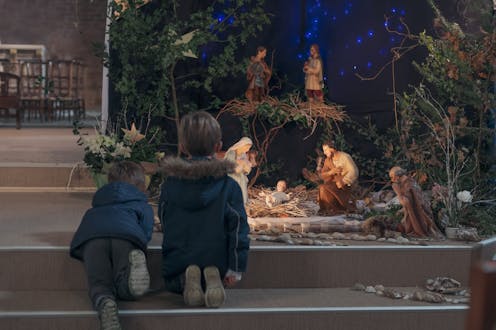
Most people, including Christians, believe the origin of Christmas is the pagan feasts to worship the solar god Sol Invictus, Saturn’s god Saturnalia, or the Persian solar god adopted by the Romans, Mithras.
Academically, this view is also known as historical religions theory. The theory suggests the Catholic Church in Rome, Italy, began celebrating Christmas on December 25 in 336 CE to replace the pagan celebrations.
However, several ancient manuscripts and theories reveal that the original celebrations of Christmas began even earlier than 336 CE.
Determining Jesus’ birth date
Some sources from 200 CE implicitly and explicitly show how December 25 was determined as the date of Jesus’s birth.
Hyppolitus (170-235 CE), a prominent theologian of the Catholic Church in Rome, mentioned the date of Jesus birth in his 204 CE work, “Commentary on Daniel”.
He stated Jesus was born “in Bethlehem, eight days before the calendar of January [December 25], the 4th day of the week [Wednesday]”.
In this context, Hyppolitus used the Julian calendar, a solar calendar introduced by Julius Caesar in 46 BCE.
But in Jewish tradition, the date of conception of holy person coincides with the date of death. Early Christians believed that March 25 was when Jesus was crucified.
Based on this theological assumption, the calculation shows that Jesus’ conception also happened on March 25. This means, Jesus was born exactly nine months later, or on December 25. This theological-based calculation is known as Calculation Theory.
The theory suggests Jesus’s birth date has not linked to the pagan rituals to worship Sol Invictus, Saturnalia and Mithras, since the pagan feasts were not celebrated on December 25.
Sol Invictus was likely celebrated on August 8, 9, or 28, October 19 or 22, or December 11.
Saturnalia was celebrated between December 17-23.
As for Mithras, there is no compelling evidence that it was celebrated on December 25.
The origins of Christmas celebrations
Three different manuscripts further prove Christmas was celebrated before 336 CE. Didascalia Apostolorum, Liber Pontificalis, and Epistle of Theophilus The texts provide information on the pastoral life of early Christians, their religious ceremonies (liturgies) and the names of popes.
Didascalia is an ancient text from 250 CE. The text mentions the celebration of the Epiphany, the manifestation of Christ to the ordinary people. The Catholic Church celebrates Epiphany to commemorate the visit of three wise men in Bethlehem.
The Eastern Orthodox and Orthodox churches celebrate the Epiphany to commemorate the baptism of Jesus. Epiphany is part of of Christmas feast in the Catholic, Eastern Orthodox and Orthodox Churches.
The Didascalia text states that Epiphany is celebrated every January 6 in the Julian calendar. When we convert this date to the Gregorian calendar, a solar calendar that has been widely used since 1582 CE until now, the Epiphany falls on December 25.
Liber Pontificalis, which contains a short biography of the popes, suggests the celebration of Christmas in 2 century CE. The text reveals that Pope Telesphorus (125-136 CE) instructed the celebration of Jesus’s birth. The text does not mention the date of the festival. However, Liber Pontificalis proves that the Christmas celebration’s history is older than we used to know.
Epistle of Theopilus mentions December 25 as the date of the celebration of Jesus birth. The text suggests that the celebration was prior to 196 CE, thus, it is likely the Christmas has been celebrated before that.
The three texts above prove that the origin of Christmas is not Sol Invictus, Saturnalia, or Mithras celebrations, and that Christians have been celebrating Christmas since 2 century CE.
Martinus Ariya Seta does not work for, consult, own shares in or receive funding from any company or organization that would benefit from this article, and has disclosed no relevant affiliations beyond their academic appointment.
This article was originally published on The Conversation. Read the original article.







